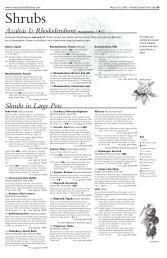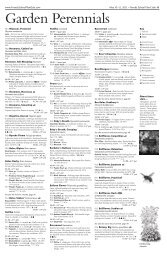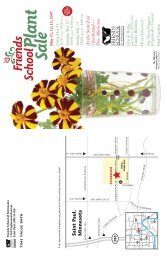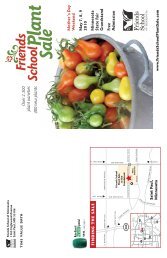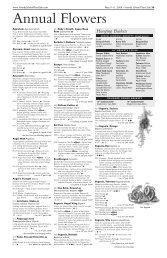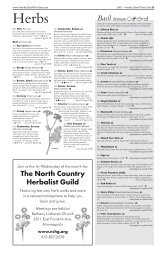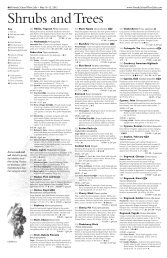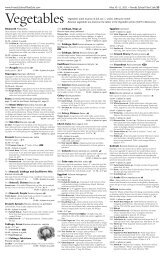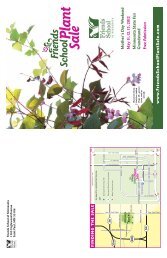2005 Catalog (PDF: 2.9MB) - Friends School Plant Sale
2005 Catalog (PDF: 2.9MB) - Friends School Plant Sale
2005 Catalog (PDF: 2.9MB) - Friends School Plant Sale
Create successful ePaper yourself
Turn your PDF publications into a flip-book with our unique Google optimized e-Paper software.
16th Annual <strong>Friends</strong> <strong>School</strong> <strong>Plant</strong> <strong>Sale</strong><br />
May 6th, 7th and 8th, <strong>2005</strong><br />
Friday 11:00 A.M.–8:00 P.M.• Saturday 9:00 A.M.–8:00 P.M.<br />
Sunday 12:00 NOON–4:00 P.M. Sunday is half-price day<br />
at the Grandstand Building, Minnesota State Fair Grounds<br />
<strong>Friends</strong> <strong>School</strong> of Minnesota<br />
Thank you for supporting <strong>Friends</strong> <strong>School</strong> of Minnesota by purchasing<br />
plants at our sale. <strong>Friends</strong> <strong>School</strong> of Minnesota prepares children to embrace life, learning,<br />
and community with hope, skill, understanding, and creativity. We are committed<br />
to the Quaker values of peace, justice, simplicity and integrity.<br />
Located in Saint Paul near Hamline University, the school has a<br />
student body of 150 and a faculty of 16.<br />
Started by Quakers and peace activists in 1988, <strong>Friends</strong> <strong>School</strong> of Minnesota has maintained<br />
a strong commitment to serving families of religious, ethnic and economic diversity.<br />
The school’s website address: www.fsmn.org<br />
<strong>Plant</strong> sale phone number: 651-917-0076<br />
Know More About Peonies<br />
BOOK REVIEW BY LILI HERBERT<br />
When Henry asked me to review<br />
these books, I was a little<br />
intimidated. Whole books<br />
about peonies? Two whole<br />
books? With lots of Latin names?<br />
My uncertainty was soon overpowered by<br />
my desire to learn more about these beautiful<br />
plants. I associate peonies with my grandfather’s<br />
garden, with quiet, calm, slow summer<br />
afternoons, and serene still-life images of vases<br />
spilling over with<br />
peony flowers, petals<br />
scattered around the<br />
base. This association<br />
is common; every<br />
print source and conversation<br />
I have had<br />
about peonies connects<br />
them to “oldfashioned”<br />
calmer<br />
times, grandmother’s<br />
garden. What better<br />
association for a<br />
flower? The antithesis<br />
to our cellphone, Palm<br />
Pilot, warring society.<br />
Happily, both books<br />
Peonies<br />
by Allen Rogers<br />
Published by Timber<br />
Press, 1995<br />
The Genus<br />
Paeonia<br />
by Josef J. Halda with<br />
James W. Waddick<br />
Botanical illustrations<br />
by Jarmiola Haldova<br />
Published by Timber<br />
Press, 2004<br />
turned out to be concise, clear, easy-to-read,<br />
and well organized. I learned about the origin<br />
of peonies and that they are easy to grow, produce<br />
beautiful, sometimes fragrant flowers,<br />
and are valued as much for the foliage as for<br />
the flower. There are two main types of<br />
peonies, called “woody” (or “tree”) and<br />
“herbaceous.” Herbaceous peonies are more<br />
common, but woody peonies are becoming<br />
more available in the United States. Many of<br />
both types are available at our plant sale.<br />
It was fun to read about how to recognize the<br />
Fernleaf Peony from the Rogers book.<br />
Continued on page 23. More articles on pages 5, 13, 20, 21 and 38.<br />
Contents<br />
About the <strong>School</strong> . . . . . . . .2<br />
What’s New . . . . . . . . . . . .2<br />
How to “Do” the <strong>Sale</strong> . . . . .3<br />
Saturday Vendor Fair . . . . .4<br />
Articles<br />
Peonies . . . . . . . . . . . . . . . .1<br />
Gardening with Natives . . .5<br />
Tea Roses . . . . . . . . . . . . .13<br />
Busting Buckthorn . . . . . .20<br />
Monarch Monitoring . . . .21<br />
Rain Gardens . . . . . . . . . .38<br />
<strong>Plant</strong>s<br />
Annual Flowers . . . . . .6–11<br />
Climbing <strong>Plant</strong>s . . . . .24–25<br />
Daylilies . . . . . . . . . . . . . .30<br />
Ferns . . . . . . . . . . . . . . . . .31<br />
Grasses . . . . . . . . . . . . . . .12<br />
Garden Perennials . . . .26–37<br />
Herbs . . . . . . . . . . . . .16–17<br />
Hosta . . . . . . . . . . . . . . . .28<br />
Lilies . . . . . . . . . . . . . . . .33<br />
Native Wildflowers . . .39–41<br />
Rare <strong>Plant</strong>s . . . . . . . . .22–23<br />
Roses . . . . . . . . . . . . . . . .13<br />
Shrubs . . . . . . . . . . . . .18–20<br />
Trees . . . . . . . . . . . . . . . . .20<br />
Vegetables and Fruit . .14–15<br />
Water <strong>Plant</strong>s . . . . . . . . . . .35<br />
Woodland Wildflowers . . .41<br />
Common Name Index . . . .42<br />
Latin Name Index . . . . . . .43






